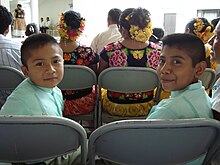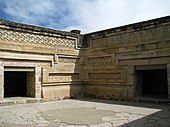Zapotec civilization
The Zapotec archaeological site at the ancient city of Monte Albán has monumental buildings, ball courts, tombs and grave goods, including finely worked gold jewelry.
Zapotec civilization originated in the Y-shaped Central Valleys of Oaxaca in the late 6th century BC.
The three valleys were divided among three differently-sized societies, separated by 80 square kilometres (31 sq mi) "no-man's-land" in the middle.
During the same period, a new large settlement developed in the "no-man's-land" on top of a mountain overlooking the three valleys; it was later called Monte Albán.
Monte Albán had become the largest city in what are today the southern Mexican highlands, and retained this status until approximately 700 AD.
These regions' unique styles were suddenly replaced with Zapotec-style pottery, indicating their integration into the Zapotec empire.
[7] In 1486, the Aztec would establish a fort on the hill of Huaxyácac (now called El Fortín), which would use to enforce the collection of tribute payments in Oaxaca.
[7] On November 25, 1521, Francisco de Orozco arrived in Valley of Oaxaca, with both the Zapotecs and Mixtecs in the area soon submitting to the rule of Hernan Cortes.
[9] The name Zapotec is an exonym; they were referred to by Nahuatl speakers as tzapotēcah (singular tzapotēcatl), which means "inhabitants of the place of sapote".
[12] Due to decades of out-migration, Zapotec is also spoken in parts of Mexico City and Los Angeles, CA.
During Monte Alban 1-2 the valley appears to have been fragmented into several independent states, as manifested in regional centers of power.
It is estimated that at the time of the emergence of Zapotec civilization, the valley soil were unaffected by the erosion seen today, as the oak and pine forests covering the surrounding mountains had not yet been decimated by logging.
Archaeologists found remains of a small irrigation system consisting of a dam and a canal on the south-eastern flank of the mountain.
[16] Likewise, crops grown in the valley were not enough to sustain the rapid population growth in the Monte Albán I phase.
[16] Innovation of farming enabled the Zapotec to pay tribute to the Spanish conquerors and create enough surplus to feed themselves despite natural disasters and disease.
[17] The Zapotecs developed a calendar and a logosyllabic system of writing that used a separate glyph to represent each of the syllables of the language.
Other important pre-Columbian Zapotec sites include Lambityeco, Dainzú, Mitla, Yagul, San José Mogote, El Palmillo and Zaachila.
The Zapotecs were a sedentary culture living in villages and towns, in houses constructed with stone and mortar.
The earliest known artifact with Zapotec writing is a Danzante ("dancer") stone, officially known as Monument 3, found in San José Mogote, Oaxaca.
One of them is that they were the original people of the valley of Oaxaca and were born from rocks, or descended from big cats such as pumas, jaguars and ocelots.
Another is that the Zapotec settled in the Oaxaca valley after founding the Toltec empire, and were descendants of the people of Chicomoztoc.
[21] According to historical and contemporary Zapotec legends, their ancestors emerged from the earth, from caves, or turned into people from trees or jaguars.
Excavation of Mound III at the Cuilapan Temple Pyramid in Oaxaca revealed a dedication cache containing many jade beads, two jade earspools, three obsidian blades, shells, stones, a pearl, and small animal bones, likely from birds, dated to 700 AD.






